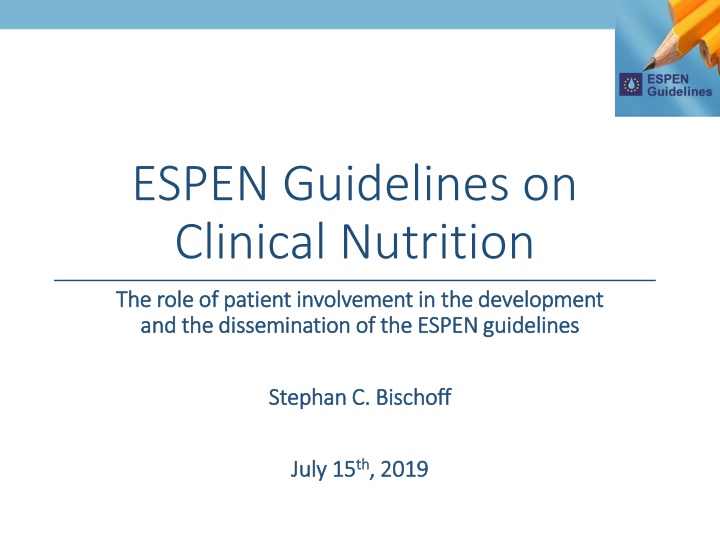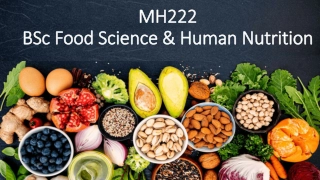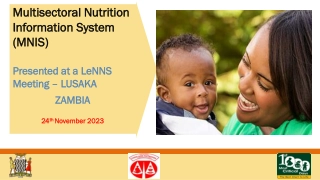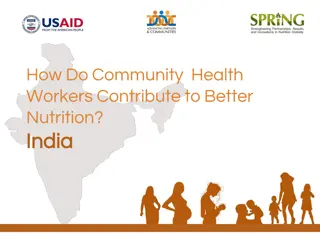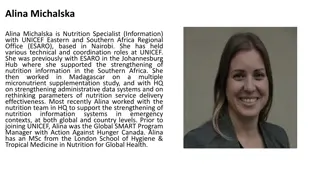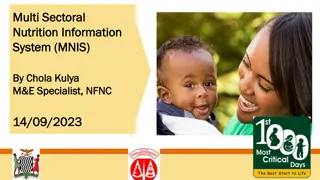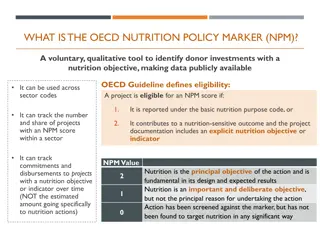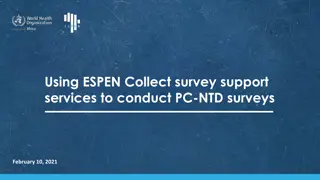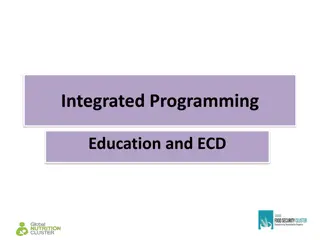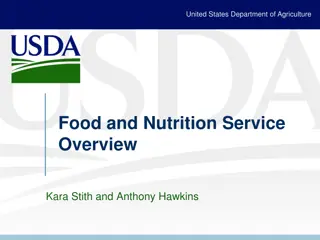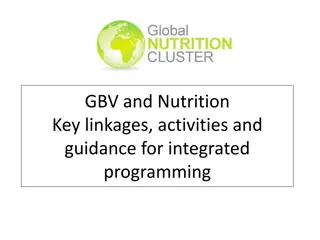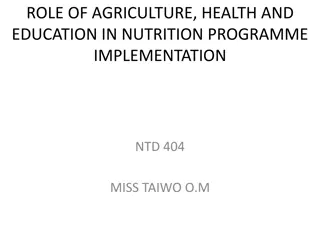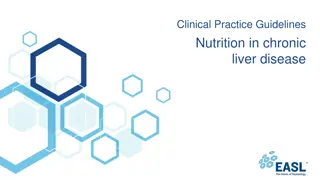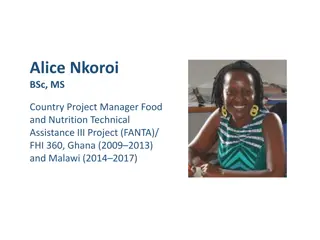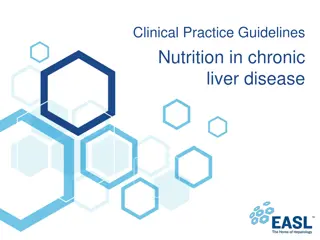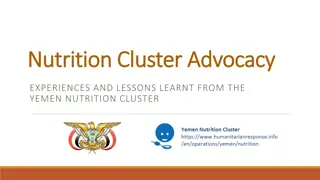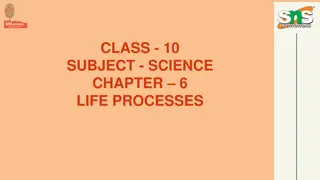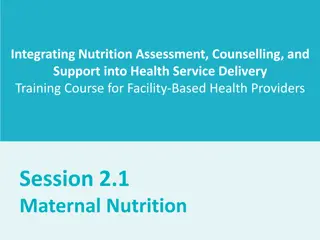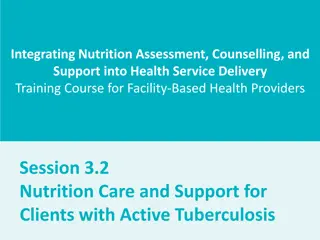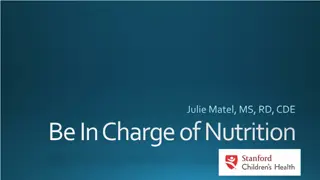ESPEN Guidelines on Clinical Nutrition
ESPEN guidelines on clinical nutrition emphasize the importance of patient involvement in the development and dissemination process to enhance understanding of therapeutic proposals and ensure broader access to valuable information. Patients' perspectives contribute valuable insights to guidelines, covering a wide range of diseases beyond professional viewpoints. The current ESPEN guidelines cover various areas including dementia, geriatrics, oncology, and more, with a structured development process involving literature grading, PICO question creation, consensus conferences, and revision stages. Patient involvement in guideline development includes reviewing topics, key questions, and recommendations to address essential aspects from a patient's viewpoint.
Download Presentation

Please find below an Image/Link to download the presentation.
The content on the website is provided AS IS for your information and personal use only. It may not be sold, licensed, or shared on other websites without obtaining consent from the author.If you encounter any issues during the download, it is possible that the publisher has removed the file from their server.
You are allowed to download the files provided on this website for personal or commercial use, subject to the condition that they are used lawfully. All files are the property of their respective owners.
The content on the website is provided AS IS for your information and personal use only. It may not be sold, licensed, or shared on other websites without obtaining consent from the author.
E N D
Presentation Transcript
ESPEN Guidelines on Clinical Nutrition The role of patient involvement in the development The role of patient involvement in the development and the dissemination of the ESPEN guidelines and the dissemination of the ESPEN guidelines Stephan C. Bischoff Stephan C. Bischoff July 15 July 15th th, 2019 , 2019
ESPEN ESPEN European Society European Society for Clinical Nutrition and Metabolism Clinical Nutrition and Metabolism for ESPEN is dedicated to all issues relevant to the field of clinical nutrition and metabolism and promotes: basic and clinical research basic and advanced education organization of consensus statements about clinical care and care quality control ESPEN guidelines
Importance Importance of of patient patient involvement involvement Growing desire for understanding therapeutic proposals Broader availability of information Limited understanding of specialist terms Solution: Lay versions Guidelines: should cover all aspects of a disease, not only the profesionals point of view Patients contribution adds value to guidelines
Current Current ESPEN Guidelines ESPEN Guidelines 1. Dementia 11. Geriatrics 2. Chronic intestinal failure 12. Pediatrics 3. Cystic fibrosis 13. ICU 4. Oncology 14. Hepatology 5. Ethics 15. Home enteral nutrition 6. Terminology 16. Home parenteral nutrition 7. IBD 17. Pancreas 8. Surgery 18. Nephrology 9. Polymorbid 19. Hospital Food 10. Neurology 20. Micronutrients
Guideline Guideline development development process process Patient/Problem Intervention Comparison Outcomes 2++ 1+ 2+ 1++ 2- 1- Literature grading according to SIGN* Working group Literature search Creation of PICO questions Generation of recommendations Consensus Conference Revision Online voting Publication & Dissemination Finalization of the guideline Formal check * Scottish Intercollegiate Guidelines Network: SIGN 50: A guideline developer s handbook. Quick reference guide October 2014
Patient Patient involvement involvement in development development in guideline guideline Review of topics and key questions (PICO s) > Are all necessary points from a patient s view addressed? Review of the recommendations > Do the recommendations address the patient s needs? > Do the commentaries address the patient s needs? Participation in the online discussions & voting Attendance of the Final Consensus Conference Or sending comments if the state of health does not allows personal participation
Current Current ESPEN Guidelines ESPEN Guidelines 1. Dementia 11. Geriatrics 2. Chronic intestinal failure 12. Pediatrics 3. Cystic fibrosis 13. ICU 4. Oncology 14. Hepatology 5. Ethics 15. Home enteral nutrition 6. Terminology 16. Home parenteral nutrition 7. IBD 17. Pancreas 8. Surgery 18. Nephrology 9. Polymorbid 19. Hospital Food 10. Neurology 20. Micronutrients
Spreading Spreading knowledge knowledge on across across Europe Europe UEG on malnutrition malnutrition UEG grant grant 2018 2018 - -2020 2020 1. Short versions ( Practical guidelines 2. National language versions 3. App versions 4. Lay versions / patient versions
Patient Patient involvement involvement in dissemination dissemination ( (lay in guideline guideline lay versions versions) ) Practical Guidelines provided by ESPEN Transformation by 2-3 patient representatives No change of recommendations Translation / explanation of recommendations Simplification of the commentaries Proof-reading by ESPEN English language Future plan: national languages
10 ESPEN Guidelines 10 ESPEN Guidelines selected selected 1. Dementia 11. Geriatrics 2. Chronic intestinal failure 12. Pediatrics 3. Cystic fibrosis 13. ICU 4. Oncology 14. Hepatology 5. Ethics 15. Home enteral nutrition 6. Terminology 16. Home parenteral nutrition 7. IBD 17. Pancreas 8. Surgery 18. Nephrology 9. Polymorbid 19. Hospital Food 10. Neurology 20. Micronutrients
10 ESPEN Guidelines 10 ESPEN Guidelines selected selected 1. Chronic intestinal failure EU Cancer patients (ECPC), Isabelle Manneh 2. Oncology 3. IBD 4. Surgery 5. Polymorbid 6. Neurology 7. Geriatrics 8. ICU 9. Hepatology 10. Home enteral nutrition
Thank you! Information: guidelines-office@espen.org
